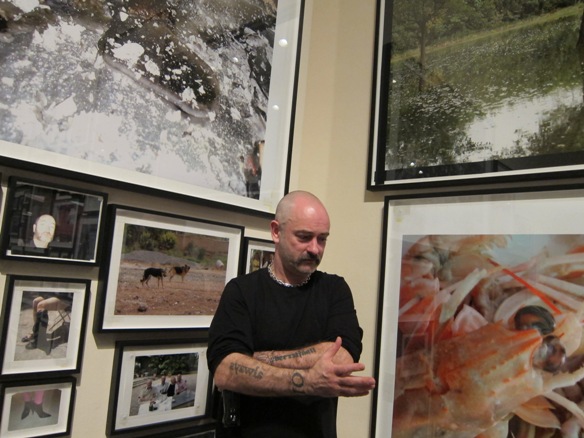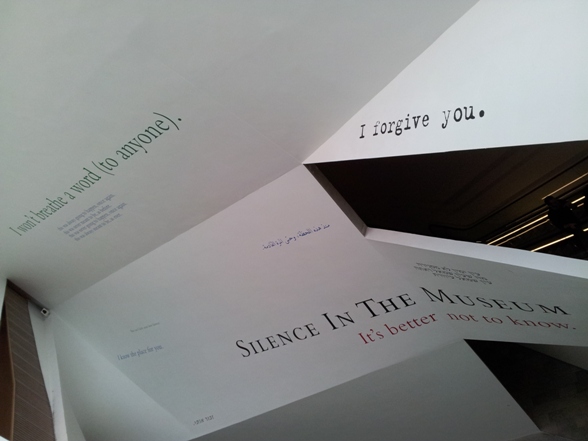“It really astonishes me as a Scottish person living an international life to end up in Tel Aviv,” said Douglas Gordon, “to do one of the most comprehensive, introspective shows of my life. I don’t know if I can ever do this again.”

The exhibition I Am Also…Douglas Gordon, spanning twenty years in the artist’s career, will open to the public on Friday, January 25, 2013, at the Tel Aviv Museum of Art. Museum Director Suzanne Landau, the exhibit’s curator Ami Barak and Douglas Gordon invited the press for a preview tour of the exhibition this past Monday, January 21st, as it was in the final stages of preparation.
“It’s a little unusual for me to present work in a state like this,” Gordon said, yet generously offered the visitors a guided tour of the exhibition, with commentary.
“When I first started coming to Tel Aviv this building didn’t exist. I have to say that I love the old building very, very much and I have half of my life in the old building, you’ll see that later… and when I saw this building I thought: it is incredibly beautiful and almost operates like a grand circus tent, and I always wanted my work to be in the circus… a circus of images, a circus of events, a circus of sounds.”
The exhibition includes some of Gordon’s best known works, 24 Hour Psycho (1993), Play Dead; Real Time (2003), new works such as Henry Rebel (2011), and The End of Civilisation (2012), and Gordon has been installing text works – spanning 20 years – within the unique architecture of the Light Fall in the Herta and Paul Amir Building. Curator Amir Barak said, “It is every curator’s dream that an artist integrate the museum into his art, and integrate the art into the museum”

Touring the exhibition with Gordon revealed yet another aspect of the artist – a warm and playful raconteur.
One stop along the way is the film Zidane: A 21st Century Portrait (2006). For those readers who have missed part of the current century, Zinedine Zidane is an excellent football player, considered one of the best, who played for the French National team, Juventus and Real Madrid.
“I wanted to create a portrait for the 21st century,” said Gordon, “I wanted to take the player out of the team 17 cameras on him. For me, this is a critical and key work. The genesis, the birth of this work was a large group exhibition in 1996, Art Focus. One of the artists was Philippe Parreno. We had the installation up quickly and had a lot of time on our hands. We were near Teddy Stadium (in Jerusalem), just hanging around, and decided to go to the mall to buy a football. We played for three or four days and started talking about making a film where the main character is always there…we never follow the ball, we always follow the man.”
Noting the neat fit between a football match, which is 90 minutes long, and a feature film, Gordon said of his choice of subject, “I loved Zidane… we know David Beckham wears certain underpants, uses a certain cologne, we don’t know anything about Zidane, he only exists when the whistle blows, until the end. What can we do with this portrait of a man who is unknown?… for someone of my generation to make a portrait is quite provocative…the film bridges a technological shift in the world, with thirteen 35 mm cameras, two 16 mm cameras, and two HD cameras.”
Gordon ruefully recalled, “Speaking to Zidane [about making the film] we said, we are professionals, we don’t want a photo, we don’t want an autograph … I wish I had a photo… there’s a kind of fantasy idea that he is the man we wanted to be.”
Entering another room in the museum, with a multitude of video screens, Gordon said, “This is my CT scan… it also functions as some kind of a self portrait.” Pointing to different screens, Gordon indicated, “This is Cambria last year, Marrakesh three years ago, Poznan 2009… it’s like a diary of events for me: it’s everything as a postcard, and then the real letter will reveal itself…”
Moving on to the Main Building of the museum, where an intriguing assortment of photographs was almost completely hung (Gordon quipped that he was waiting for the election results to finish work in this room), the artist addressed his attentive audience.
“The title of this show “I Am Also” is a big reference to Robert Louis Stevenson, one of the many great Scottish authors, and this is a big reference to the really heartbreaking confession from Dr. Jekyll when he says “I am also Hyde.” It’s a human being realizing, recognizing, admitting, confessing that they are also not who they appear to be. I Am Also…Douglas Gordon – I don’t know where that works… but that is a nice game you could play, so in a way this piece of work which is called I am Also Hyde is a direct reference to Stevenson, and if you look at the images you might discover the smoke screen or the fog that I build every day in order to be myself.”
“When I showed this work in Paris, for the first time some of my students I teach…believe it or not, I’m a professor. Some of my students thought that it is a totally pretentious work, it’s only about food and sex and kids,” Gordon paused, and said, “I am also Hyde…. what is it about if not that?”
Gordon who stated that he had a “strange relationship with Tel Aviv” said, “I think that the opportunity and the challenge for me to be doing something here in Israel, in Tel Aviv, allowed me to expose myself within limits. Because I think there is something very special about… let’s say this Semitic culture where say, exposing oneself in language is like nowhere else. Scottish people shut up. Believe it or not we never even take a poo… we never poo, we never pee, we don’t do anything, we never have sex… I don’t know how the culture survived. Semitic culture for me represents this idea of I can’t keep it in, I have to get it out…and when I say Semitic, you know what I am talking about, not only Hebraic.”
Calling the exhibition a “mid-career introspective” Gordon shared some thoughts on life and art, as well as pointing out some of the more piquant origins of images on display.
“Hey, I’m going to be dead soon, and I have to give the work the energy I can today, hopefully tomorrow…every time I saw a piece of work by Marcel Duchamp, even though it represents a certain high bourgeoisie intellect, it’s imbued somehow, it’s still imbued with a resonance from the man who made it….and when I started to work on this exhibition before Ami was involved, and before Suzanne was here, this was when Motti was still director. Motti came to my studio in Berlin and said I think there’s something that you have to address about the Duchampian relationship with the audience, not the object, the audience.”
“You must tell me in Hebrew: how do say residual power? In Judaism, one of the reasons I was so attracted to Semitic culture – the idea that the object passes from one generation to the other, the image passes, the language passes, and it retains some kind of a bizarre DNA virus – let’s say a positive virus. In Scotland when something happens we go like that [Gordon illustrated his words with his shoe, rubbing out all traces of ‘something’]: done, dead, over, finished. And what I like here and what’s very important for me with this work, is that my children will be part of the audience and they will describe it to their friends and there’s a ripple effect of how the work becomes significant in the world.”
Gordon walked through the room at a brisk pace, tossing out comments in what remains a fairly strong Scottish accent, not always decipherable to Israeli ears:
“This is my friend from the [undecipherable] market, he introduced me to snakes. He put one on my head, he said: your girlfriend is pregnant she’s a Jew. Kiss the cobra it’s good luck – I did it.”
“This is a one-eyed cat.”
“This is my friend Rufus Wainwright.”
“I work with fire a lot cause I think that burning things isn’t necessarily destruction. This is the aftermath of a fire in my studio.”
“One of the best cemeteries I’ve ever had sex in.”
“Some amazingly ferocious dog from Marrakesh.”
“Some vodka that I drunk in Poland when I was food and drink critic for Playboy magazine. It’s the only proper job I ever had.”
Although the artist will not be there to accompany each and every visitor, the exhibition offers an extensive look at the work of this intriguing artist. I Am Also…Douglas Gordon will open to the public on Friday, January 25, 2013 and remain up until Sunday, May 26, 2013. See more photos from the preview tour here.






After your captivating preview, can’t wait to see this show
Comments are closed.